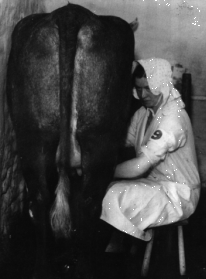How to milk a cow
... or a goat, or even a sheep
You need very clean equipment, and very clean hands.
Young people milk most easily, since they are supple and can bend down and their fingers are not yet arthritic. Women were thought to milk more sympathetically than men.

Give the cow a feed so she stands patiently and looks forward to milking.
Place the bucket just forward of the udder. Sit on a stool beside the cow facing her tail. Tuck your shoulder and head against her flank.
Reach under her and take hold of two teats gently but firmly. Squeeze your fingers in sequence from the top down, using the upper finger to make a seal and move the milk downward. Keep your hands pushed up slightly against the udder; you don't need to pull! You are copying the sucking movement of the calf's tongue and mouth.
Alternate the squeezing movement with each hand until these two quarters are empty.
For a goat or a sheep this is enough as they normally only have two teats. For a cow, there are another two to go! (she has four.) One dairy cow produces on average, 10,409 pints of milk in a year; or about 3.5 gallons (28 pints) a day; more when she is in "full milk" shortly after calving, dropping away as she approaches her next calving.
A good modern dairy goat will give up to a gallon (8 pints) at one milking when she is milking well in early summer. She will milk twice a day up to a couple of months before her next kidding, when she will dry off. For both cows and goats, the yield also drops during winter unless concentrate feeds and high quality silage are fed to them.
And for all you lactovegetarians out there - a cow has to have a calf every year (often less; the gestation period is 9 months) in order to give milk continuously for butter, cheese, and milk products like yogurt, ice cream and creme fraiche. What will you do with a bull calf? Think about it.